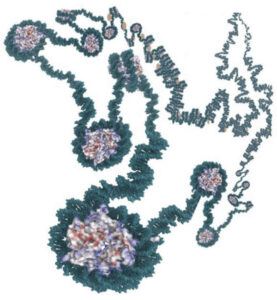It has been nearly 6 years since I first stumbled upon the term epigenetics. It’s the study of how our behaviors and environment regulate the way our genes work. One might refer to it as the science of living DNA. Thanks to a wonderful lecture series by Dr. Charlotte Mykura entitled Epigenetics: How Environment Changes Your Biology, I have a little better understanding of how this mechanism works.
In my rudimentary understanding of DNA, I pictured pristine, straight-edged, double-helix strand with a left twist. When called into action, I assumed that it “unzipped” to allow its code to be copied and then “zipped back up” to its previous state. The latter is mostly right, the former not so much.
 Acetyl groups, methyl groups, and proteins of all shapes and sizes bind to DNA causing portions of it to remain open and active, and other portions to lie dormant. Scientists refer to DNA with all its molecular attachments as chromatin. Euchromatin refers to open DNA that expresses its genome; heterochromatin refers to tightly packed, “sleeping” DNA. Far from the neat and tidy lines of genetic code, DNA contorts into wild 3-D shapes, takes on and shakes off attachments, and wiggles around in response to neighboring organic material.
Acetyl groups, methyl groups, and proteins of all shapes and sizes bind to DNA causing portions of it to remain open and active, and other portions to lie dormant. Scientists refer to DNA with all its molecular attachments as chromatin. Euchromatin refers to open DNA that expresses its genome; heterochromatin refers to tightly packed, “sleeping” DNA. Far from the neat and tidy lines of genetic code, DNA contorts into wild 3-D shapes, takes on and shakes off attachments, and wiggles around in response to neighboring organic material.
In addition to the influence of molecular attachment, DNA expression can be affected by what happens outside the cell’s nucleus. DNA relies upon messenger RNA to carry information its codes to ribosomes for protein synthesis. MicroRNA in the cytoplasm can break down mRNA such that no protein gets made. Or, another RNA string might get spliced into the mRNA strand and alter expression of the gene. And PRotein infectIONs (PRIONs) within the cytoplasm can manipulate proteins after they’ve been formed, generally not for the better. (Apparently, this mechanism was at play with the outbreak of Mad Cow disease.)
In short, if you think your genes determine the life you will lead – for better or worse – think again. While a subset of your encoding remains active and stable, a whole lot can be influenced epigenetically by your environment.
Here are some examples of how epigenetics plays out in our bodies:
- While every cell in the body contains the same DNA, epigenetics impacts how the cell behaves based on its location. For example, if it’s in the gut, it will use its programming to digest food, produce vitamins, support healthy immune function, and eliminate waste. It knows not to grow hair, teeth, or toenails in that environment even though it has access to the codes to do so!
- The brain is a hot bed of epigenetic activity. It’s the mechanism through which the brain learns and grows, building complex neural networks and pairing back connections that are rarely used.
- Our immune system also provides a stellar example of epigenetics in action. It has the ability to adapt dynamically to new pathogens and develop targeted responses that will eliminate them.
- The fetal environment exerts a profound influence on a child’s epigenetic structure. If the mother starved during pregnancy, the child’s DNA will have far less DNA methylation, causing excess conservation of fat and elevated risk of diabetes type 2. If the mother produced high levels of cortisol during pregnancy due to stress, the child will develop more cortisol receptors and be predisposed to anxiety, schizophrenia, and/or autism.
- Persons living with obesity have a different epigenetic signature in their guts than thin persons, making it more difficult to process fat and sugar. Moreover, when fat accumulates in the blood vessels, it influences the surrounding cells epigenetically, making them proinflammatory.
- Food is the largest environmental impact on epigenetics. When we eat healthfully, we promote a healthy expression of our genes. While an obese person may face a steep climb to reverse years of poor dietary choices, the body will respond favorably in time.
- Exercise is good for epigenetic health. DNA methylation has been correlated with muscle loss and frailty in older adults. Methylation shows signs of removal after just 20 minutes of cardio exercise. Moreover, biochemical signaling molecules released during exercise travel to the heart and lungs, exerting a positive epigenetic effect that decreases the risk of disease.
- Pollution damages DNA epigenetically by overwhelming our natural cellular repair mechanisms and disrupting DNA methylation. Both lead to increased risk of cancer. While it may be difficult to avoid external pollutants, we can certainly minimize our exposure by not ingesting contaminants. (In other words, don’t smoke!)
- We experience epigenetic drift as we age. Formerly tight coils of DNA can become open and floppy; formerly active DNA can curl up and go to sleep. Both influences can lead to random gene expression with adverse health consequences.
I really found the lecture series fascinating and would encourage those who have Wondrium subscriptions to view it. I am truly amazed by the marvel of the human body and how it works. I’m also encouraged to sustain healthy habits to encourage forwarding epigenetic expression.